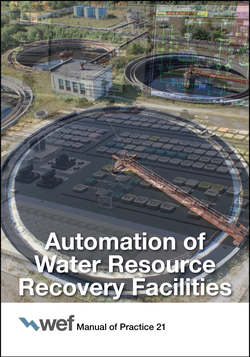Читать книгу Automation of Water Resource Recovery Facilities - Water Environment Federation - Страница 203
1.0 OBJECTIVE OF AUTOMATIC PROCESS CONTROL
ОглавлениеProcess control is needed because various disturbances disrupt a process’s efficiency. Such disturbances include both known and unknown inputs and conditions (e.g., changing flows, chemical and biological compositions, temperature, and density). Process control devices (e.g., valves, flow meters, pumps, and other process equipment) can also introduce disturbances.
Once a process is disturbed, compensation is required. Compensation can occur as part of a manual or automatic control system. Manual process control occurs when operators notice that a process variable has deviated from the desired setpoint and they manipulate a controlled variable (e.g., valve opening or pump speed) to try to return the process variable to the setpoint. Under manual control, operators determine the timing, duration, magnitude, and direction of the required adjustment based on their experiences with and knowledge of the process (see Figure 7.1 for an example of information flow in a process).
Automatic process control involves using various hydraulic, pneumatic, electromechanical, and electronic equipment to emulate manual controls (Figure 7.2). The operator establishes the objective, but automatic process control equipment executes the required adjustments.
The goal (i.e., control objective or objective function) of any control scheme must be defined in terms of measurable output variables. It may be as simple as “minimize effluent biochemical oxygen demand (BOD) of the wastewater” or as complex as “minimize sludge disposal and energy costs while keeping effluent BOD below effluent permit requirements”. If some objectives (e.g., cost) conflict with others (e.g., effluent quality and reuse), engineers typically can assign weights to each objective or use some as constraints (e.g., permit requirements).
FIGURE 7.1 Information flow in a process.
FIGURE 7.2 An example of information flow in feedback process control.
Often, the objective will be stated in terms of keeping one output variable as close to a desired value (i.e., setpoint) as possible. One example of a setpoint is “maintain dissolved oxygen level close to 2 mg/L”. In other instances, the objective will be to minimize one parameter (e.g., energy use).
